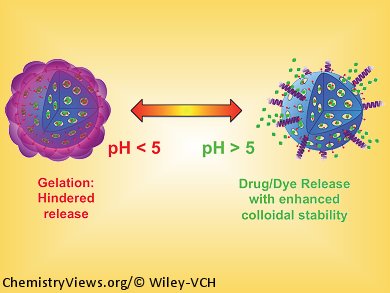Protecting Drugs Against Stomach Acid
How can pharmaceuticals be safely carried through the acidic environment of the stomach and into the intestines? A team of Canadian and Australian researchers has developed a novel nanotransporter that consists of porous particles of silicon dioxide stabilized with a whey protein. In acidic environments the protein forms a gel that closes off the pores; at higher pH values, the pores are opened.
For pharmaceuticals, both the drug itself and its form of delivery are important, as the latter determines where and when the drug becomes active in the body. For example, extended-release formulations are designed to maintain a steady level of the drug over a longer period of time and antitumor drugs are meant to become active in diseased cells as selectively as possible in order to minimize side effects. To make this work the drugs have to be “packaged” correctly. Packaging is also often required for medications administered orally because many drugs are destroyed by stomach acid before they can reach the intestine to be absorbed into the bloodstream. However, the protection against acid must also release the drug under the conditions found in the intestine.
One highly promising type of drug “package” is the mesoporous silicon dioxide nanoparticle. These are biocompatible and easy to make with the required pore and particle sizes. The chemistry of their inner and outer surfaces can easily be modified, they can easily be loaded with drug molecules of various sizes, and these can in turn be released in a controlled fashion. However, these particles have a tendency to aggregate under physiological conditions, which can completely change their properties. Also, new methods must be developed to ensure selective release at the desired target. The change in pH in the transition from stomach to intestine is a potential trigger.
Whey Proteins Prevent Aggregation
A team led by Shi Zhang Qiao at the University of Queensland, Brisbane, Australia, and Freddy Kleitz at the Université Laval, Quebec, Canada, has now refined some silicon dioxide nanotransporters, they report in the journal Angewandte Chemie. Their success stems from their use of β-lactoglobulin, a whey protein used as a dietary supplement. The researchers attached this to the outer surface of the porous nanoparticles, preventing their aggregation and increasing their biocompatibility. At pH values below 5, like those found in the stomach, β-lactoglobulin gels: it swells up and forms a gelatin “shell” around the nanoparticles, which clogs the pores and prevents the drug from exiting. At higher pH values like those in the intestines, the protein assumes the form of discrete molecules, opening the pores and releasing the drug.
As well as the stomach and intestine, other organs also have different pH values—and there are even pH differences between certain tumors and the surrounding healthy tissue. Further development of this new procedure may possibly be used to make nanotransporters capable of reacting to such subtler pH gradients.
- pH-Responsive Nutraceutical–Mesoporous Silica Nanoconjugates with Enhanced Colloidal Stability,
Rémy Guillet-Nicolas, Amirali Popat, Jean-Luc Bridot, Gregory Monteith, Shi Zhang Qiao, Freddy Kleitz,
Angew. Chem. Int. Ed. 2013.
DOI: 10.1002/anie.201208840




